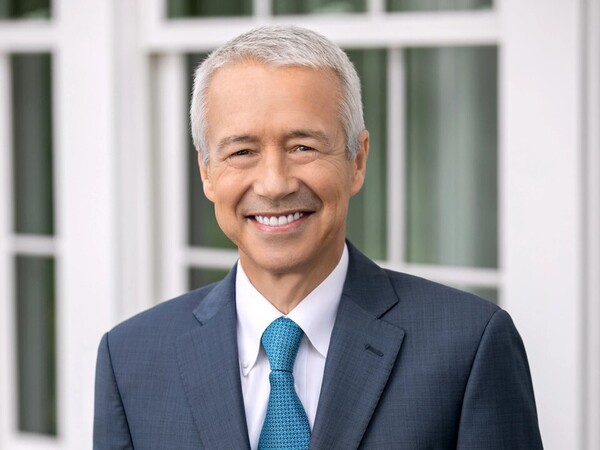SAN FRANCISCO, Calif. -- By Kim Chan-hyuk/Korea Biomedical Review correspondent -- Johnson & Johnson CEO Joaquin Duato said the potential of the combination of Leclaza (lazertinib), known as Lazcluze internationally, and Rybrevant (amivantamab) is undervalued in the marketplace, drawing keen attention from industry insiders.
Speaking at the 43rd annual J.P. Morgan Healthcare Conference on Monday (local time) at the Westin St. Francis Hotel in San Francisco, Duato cited the Leclaza-Rybrevant combination therapy as one of the company's key assets that he believes is undervalued by the market.
“The Rybrevant combination has been shown to extend survival by more than a year in lung cancer patients with a life expectancy of three years. We are currently evaluating a subcutaneous formulation and believe that the combination will eventually become the standard of care for first-line treatment,” Duato said.

He also said J&J plans to expand the indications for Rybrevant. In addition to lung cancer, the drug is expected to show promise in other EGFR-related cancers, with scheduled phase 3 trials in colorectal and liver cancer.
Notably, the session, which took place in the Grand Ballroom, the event's main stage, was attended by representatives from Yuhan Corps, the Korean company that licensed Leclaza’s global rights to J&J, including Kim Yeol-hong, president of R&D. The combination of Leclaza-Rybrevant was recently approved in Korea for the first-line treatment of non-small cell lung cancer (NSCLC).
Market potential of Tremfya and TAR-200 stressed as ‘innovative products’
In addition, CEO Duato highlighted two other key company assets that he believes are underappreciated in the market: the interleukin (IL)-23 inhibitor Tremfya (guselkumab) and the bladder cancer treatment TAR-200 (gemcitabine), which utilizes the drug release technology platform TARIS.
“Tremfya has shown the best efficacy in both previously treated and untreated patients and is the only subcutaneous formulation (of the treatment options) available,” he said.
Duato compared Tremfya to J&J’s other autoimmune disease drug, Stelara.
“Stelara had 75 percent of sales in IBD and 25 percent in psoriasis and psoriatic arthritis,” he noted. “Currently, Tremfya generates $1.26 billion in sales from psoriasis and psoriatic arthritis alone. Considering this, Tremfya has the potential to be worth more than $10 billion.”
Commenting on TARIS, Duato said, “Although misunderstood by some as a medical device, TARIS will be approved as a drug. Of the 600,000 new bladder cancer cases and 400,000 recurrences each year, 70 percent are non-muscle invasive bladder cancer, most of which are high-risk.”
TAR-200 can be administered in the physician’s office in three minutes, cleaned up in one minute, and requires no special storage conditions, he said, adding that he sees a market potential of more than $5 billion (7.3 trillion won).
‘J&J highlights leadership in multiple myeloma treatments’
During the presentation, Duato also expressed confidence in J&J's leadership in multiple myeloma, saying, “J&J has developed more than half of the treatments for multiple myeloma over the past decade.” He projected that by 2030, the field will grow into a $25 billion franchise, with more than 50 percent of the market filled by J&J's treatments.
Duato also commented on the company's recent $14.6 billion acquisition of Intra-Cellular Therapies.
“Neurology is one of our core areas,” he said, noting that the company's flagship product, Caplyta (lumateperone), has a sales potential of more than $5 billion. Caplyta is approved for treating bipolar disorder types 1 and 2 and schizophrenia and is also under review by the U.S. Food and Drug Administration for treating major depressive disorder.
Regarding the financial outlook, Duato emphasized that he is “confident in achieving 3 percent growth in 2025 and a 5-7 percent compound annual growth rate from 2025 to 2030.”
Concerning M&A strategy, Duato noted that the company has invested about $30 billion in R&D and M&A over the past two years and will continue to do so.
“Large acquisitions are rare,” Duato said. “J&J created value through 75 smaller transactions over the past year, and many of its breakthrough products, including the oral IL-23 inhibitor (JNJ-2113) and TAR-200 under development, originated from these smaller transactions over a decade ago.”
Related articles
- [JPM2025] J.P. Morgan’s executive discusses APAC’s healthcare investment landscape
- [JPM2025] J.P. Morgan Healthcare Conference opens with positive outlook for 2025, strong M&A expectations, and prominent Korean biopharma presence
- [JPM2025] Nvidia unveils AI-powered solutions to revolutionize healthcare at J.P. Morgan Healthcare Conference
- SC formulation of Rybrevant-Leclaza combo therapy endorsed for approval in Europe
- J&J Innovative Medicine expands insurance coverage for Darzalex in multiple myeloma treatment
- Yuhan’s IgE inhibitor gets green light in phase 1 trial for chronic urticaria
- Yuhan's 2024 revenue surpasses ₩2 trillion thanks to lung cancer drug
- Researchers find ways to diagnose lung cancer mutations with blood droplets
- Yuhan says allergy drug candidate tops Novartis' Xolair, eyes blockbuster licensing deal
- Will Leclaza-Rybrevant combo therapy open new horizon for EGFR lung cancer treatment?
- First pathological complete response reported for Yuhan’s Leclaza
- J&J: Yuhan-partnered lung cancer combo may beat AZ’s osimertinib in survival by a year
- EU approves J&J’s injectable Rybrevant with Yuhan’s Leclaza for lung cancer
- Janssen's bladder cancer drug hits snag in Korea's orphan drug review
- J&J's Tremfya scores Korean nod in Crohn’s disease and ulcerative colitis

